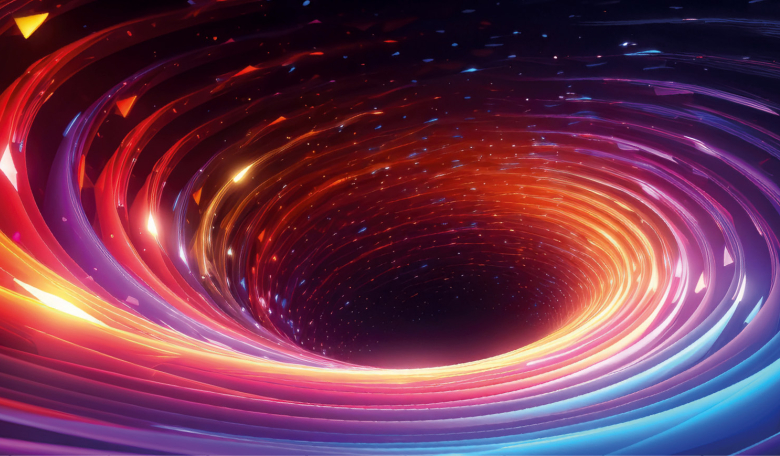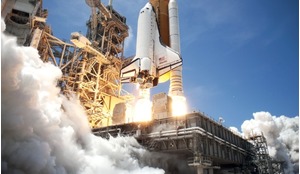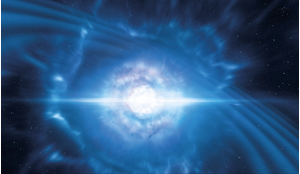We live in a pretty screwy universe - ‘screwy’ in the rotational sense that everywhere we look, and at virtually all scales, we see objects with angular momentum. That fact may not seem especially remarkable until you recall that angular momentum is a conserved quantity in physics, so all circulatory motion really needs an explanation. Few cosmology textbooks seem to address the topic in much detail, so, in this article, Stuart Eves considers whether rotation might be the answer to some of the conundrums afflicting modern cosmology.
Let’s start with that ubiquitous analogy in physics discussions, the cup of coffee. If you stir your coffee when you first make it, the chances are that there will be a patch of bubbles on the surface, rotating together as if they were a solid object. That might not be entirely what you’d expect from a loosely connected patch of bubbles, but the answer, of course, is that the coffee on which they are floating is also rotating.
Also, if you stir your coffee fairly vigorously, you’ll create a small vortex in the centre of the cup, causing the surface to dip in the centre. That vortex won’t last long, but it too is an interesting example of the spatial topology that rapid rotation can achieve.
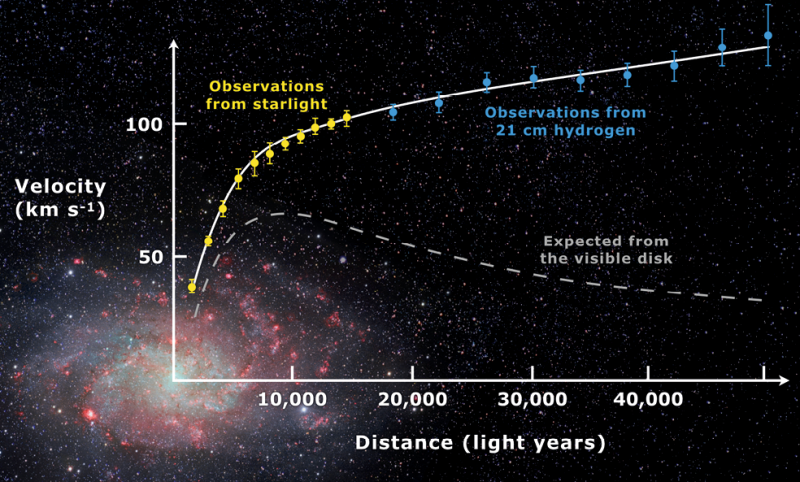 Rotation curve of the typical spiral galaxy M33 illustrates the difference between the observed and expected rotation curves for a typical spiral galaxy, which is the source of one of the puzzles that require resolution.
Rotation curve of the typical spiral galaxy M33 illustrates the difference between the observed and expected rotation curves for a typical spiral galaxy, which is the source of one of the puzzles that require resolution.
Galactic rotation
Angular momentum is a conserved quantity in physics, so all circulatory motion really needs an explanation
So let’s apply this to galaxies. If you’re familiar with the subject, you’ll know that the most frequent references to rotation in cosmology textbooks are to the motion of spiral galaxies. It has been recognised for some time that these assemblages of stars have an awful lot of angular momentum.
However, the basic problem is that stars at the edge of a galaxy are travelling much too fast to be gravitationally bound to the galaxy in which they reside and should, by rights, be flying off into space… which clearly they aren’t. This discrepancy is one of the principal arguments in favour of ‘dark matter’, which is assumed to occupy a ‘halo’ around spiral galaxies, exerting a gravitational influence which keeps the stars in place.
A rather more fundamental question, though, is: “where does all this rotational energy come from in the first place?”
It is technically feasible that rotational motion could be imparted via gravitational tidal interactions between two massive objects moving past one another in space, but that mechanism implies that we live in a cosmos filled with pairs of objects rotating in complimentary directions, and at a galactic scale. It’s not clear that we do.
Taking our own galaxy, the Milky Way, as a specific example, it would seem reasonable to ask which large, relatively adjacent object is our counterpart if this tidal mechanism is the physical cause of our galaxy’s rotation. At first sight, perhaps the best candidate would appear to be the Great Spiral Galaxy in Andromeda (M31) - it is at least large enough to have a significant gravitational influence on a galaxy the size of our own.
Note, however, that if two galaxies interact, they might be expected to spin each other up in a similar plane; that is, the plane that includes the line linking their centres of mass. But we perceive M31 as a spiral precisely because it is not rotating in the same plane as the Milky Way. Moreover, rather than zooming past us and off into space, M31 is actually heading towards us, so perhaps we need to find a better candidate.
The most frequent references to rotation in cosmology textbooks are to the motion of spiral galaxies
Now you might be thinking that searching for a single candidate object to account for this rotation is a misplaced idea, and that our galaxy, or indeed our solar system, might have had multiple gravitational interactions over their lifetimes. That may well be the case, but multiple gravitational interactions imply multiple different encounter geometries, and in an ‘isotropic universe’ (which is the same in all directions), those geometries could in theory occur at almost any angle.
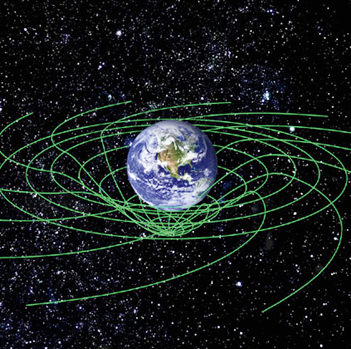 If you were to drop a large spinning mass such as a ball on a rubber sheet, the friction between the two would stretch and twist the rubber, leading to a significant distortion of the grid pattern - and, if the ball were spinning very rapidly, you might even get a vortex.
If you were to drop a large spinning mass such as a ball on a rubber sheet, the friction between the two would stretch and twist the rubber, leading to a significant distortion of the grid pattern - and, if the ball were spinning very rapidly, you might even get a vortex.
In fact, multiple tidal interactions would be much more likely to result in an elliptical structure, rather than a spiral galaxy that has been repeatedly accelerated in one direction. Indeed, multiple interactions (or mergers) between spiral galaxies are often invoked as the most likely way to form the giant elliptical galaxies. Rather unhelpfully, if you favour the tidal interaction explanation of spiral galaxy rotation, in this scenario the centres of mass of the two galaxies attract each other and they coalesce to form a single elliptical structure.
In summary, therefore, to create a spiral galaxy, and avoid ending up with an elliptical galaxy, we presumably require a very limited number of tidal interactions to occur, and at velocities which are too high for gravity to lead to mergers between the interacting objects. Does this high-velocity interaction scenario fit well with the Big Bang theory? It’s not immediately obvious that it does.
Rotation and the Big Bang
The expansion of the universe is generally assumed to be largely non-rotational, since we don’t observe a significant velocity dipole in the cosmic microwave background; and, in theory, space expands in all directions at a consistent rate, so we don’t tend to find massive objects passing one-another at high relative velocities. This problem is arguably worse than it may at first appear.
Just how much intrinsic rotation in the universe might be consistent with our current observations? Consider the following thought experiment: suppose that, taking all the millions of rotating galaxies, we could find ‘pairs’ that would cancel out the tidally-induced rotation for all but one spiral galaxy. And then imagine that we are trying to account for that single remaining spiral galaxy’s angular momentum in the context of a Big Bang (or Big Crunch) event.
Recalling that the angular momentum of a rotating object is given by the expression mωr (where m is mass, ω is angular velocity and r is radius), we can consider what might happen to a star if it were moved from an orbit at the edge of the galaxy, at a radius of around 50,000 light years and a velocity of 100 km/s, to a position just 16 light years from the centre.
The angular momentum of just one spiral galaxy would be very hard to ‘fit’ into the inflationary model
Assuming just for a moment that the star’s mass is invariant, by decreasing the orbital radius by a factor of 3000 we could only conserve angular momentum by increasing the angular velocity of the star by a similar factor. But 100 km/s x 3000 is the speed of light, so even if we assume that as the velocity of the star approaches the speed of light the star gains mass in accordance with Einstein’s theory of relativity, it can be concluded that there’s a fundamental practical limit to how much angular momentum it’s possible to cram into the universe at early times.
So why does this constitute a problem? The answer is that, in order to account for the uniformity of the cosmic microwave background, cosmologists have embraced the idea of ‘inflation’… and inflation theory suggests that there was a huge, and near instantaneous, expansion of space-time after the initial Big Bang.
The inflationary epoch lasted from 10-36 seconds after the conjectured Big Bang singularity to a time between 10-33 and 10-32 seconds after that singularity. This is equivalent to expanding an object one nanometre in length (10-9 m, about half the width of a molecule of DNA) to one approximately 10.6 light years long (about 1017 m or 62 trillion miles).
It follows, therefore, that the angular momentum of just one spiral galaxy would be very hard to ‘fit’ into the inflationary model. The Big Bang really needs to be virtually non-rotational if the inflation scenario is true.
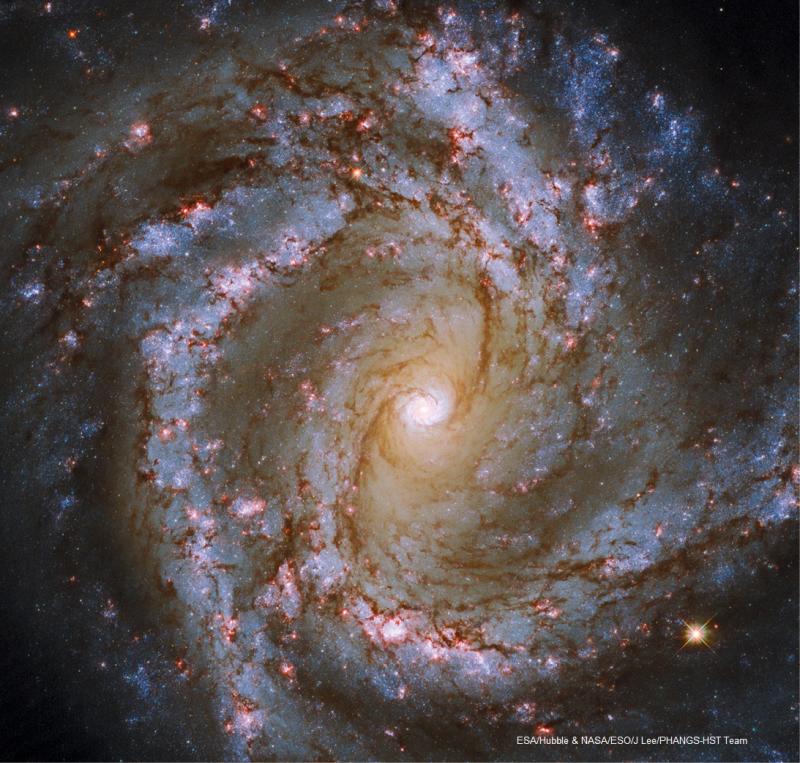 The luminous heart of the galaxy M61 dominates this image, framed by its winding spiral arms threaded with dark tendrils of dust. As well as the usual bright bands of stars, the spiral arms of M61 are studded with ruby-red patches of light. Tell-tale signs of recent star formation, these glowing regions lead to M61’s classification as a starburst galaxy. This image incorporates data from not only Hubble, but also the FORS camera at the European Southern Observatory’s Very Large Telescope, together revealing M61 in unprecedented detail.
The luminous heart of the galaxy M61 dominates this image, framed by its winding spiral arms threaded with dark tendrils of dust. As well as the usual bright bands of stars, the spiral arms of M61 are studded with ruby-red patches of light. Tell-tale signs of recent star formation, these glowing regions lead to M61’s classification as a starburst galaxy. This image incorporates data from not only Hubble, but also the FORS camera at the European Southern Observatory’s Very Large Telescope, together revealing M61 in unprecedented detail.
Cosmology perspective
If you are a student of cosmology, you will probably be aware that the universe appears to be incredibly ‘flat’; in other words, there is a critical density which represents the threshold between a universe that will increase in size forever and one where its mass is sufficient to halt the expansion and then pull the material back together into a ‘Big Crunch’.
Observations by the Planck spacecraft suggest that the universe we inhabit is very close to this critical density: as cosmologists would say, it is flat to within 0.5 percent, and homogeneous and isotropic to one part in 100,000. Moreover, these observations of the cosmic microwave background are not polarised, which has been taken to confirm the idea that the universe as a whole isn’t rotating to any significant extent.
Rotation on the scale of the universe is a mechanism that has occasionally been proposed by proponents of Steady State theories to provide a ‘centrifugal’ component to the motions of the galaxies that would prevent a gravitational collapse and keep the galaxies apart. Were this the case, however, some polarisation in the cosmic microwave background would be expected, and some observations have failed to detect this. Somewhat perplexingly, however, other researchers claim to have found some evidence of a small rotational bias which implies that the universe is in fact rotating to some degree. So perhaps we need a different model.
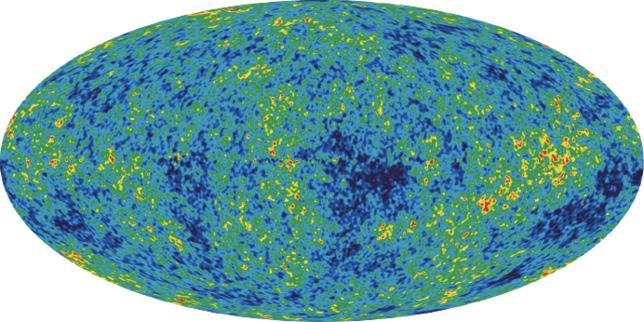 A-map-of-cosmic-background-radiation-from-when-the-universe-was-around-380,000-years-old.
A-map-of-cosmic-background-radiation-from-when-the-universe-was-around-380,000-years-old.
Stretching space-time
Observations of the cosmic microwave background are not polarised, which has been taken to confirm the idea that the universe as a whole isn’t rotating to any significant extent
You will probably have encountered the ‘rubber sheet’ analogy, in which a heavy ball is dropped onto a flexible membrane with a grid pattern to illustrate the way in which mass causes space-time to curve. A potential problem with this analogy is that the heavy ball is not usually assumed to be rotating, despite the fact that most of the large masses in the universe are.
However, to extend the analogy, if you were to drop a large spinning mass on a rubber sheet, the friction between the two would stretch and twist the rubber, leading to a significant distortion of the grid pattern. And if the ball were spinning very rapidly, you might even get a vortex.
Clearly, this is just an analogy, but a key question is whether large rotating massive objects in the universe really do twist space-time in this fashion. ‘Frame dragging’ is an acknowledged relativistic phenomenon, and it is possible that an improved understanding of this mechanism might resolve some of the current puzzles in cosmology, especially if magnetic fields are wrapped into the story.
As The Cosmic Revolutionary’s Handbook [Cambridge University Press, 2019] makes clear, there are a number of cosmological observations which represent tests for any new theory of the universe. One issue that would certainly need to be addressed is the red-shift that would be imparted to any electromagnetic radiation emitted from the central object. The Big Bang paradigm invokes the stretching of space-time to explain the observed red-shift, and any stretching of the field lines around a massive rotating object would have a similar effect.
Stretching light to longer wavelengths would imply a potential loss of energy, since the energy of a photon is directly related to its wavelength. But of course the conservation of energy is another cherished principle of physics, so perhaps the energy ‘lost’ to a space-time vortex is a source of some of the photons observed in the cosmic microwave background.
In stretching space-time, the massive object would be doing ‘work’ and, in the process, would slowly lose rotational angular velocity. If this is true for all objects in the universe, then distant objects would presumably appear to be rotating faster, and to be more red-shifted, than nearby objects, simply because their light has taken longer to reach the Earth. This is both consistent with observations and preserves the large-scale structure of the universe as a ‘foam’ (with large voids surrounded by sheets of galaxies).
If the proposed mechanism invoked here is accurate, it would help to explain some of the anomalous red-shift observations that have been reported by the likes of Halton Arp in his book, Seeing Red. In particular, his suggestion that groups of objects with different red-shift characteristics, seen in association with some quasars, would make significantly more sense if their emissions had a rotationally-induced red-shift component.
Arp’s suggestion that energetic quasars ‘emit’ objects which ‘evolve’ through a Seyfert galaxy stage to end up as spiral galaxies is a very different formation scenario to that which is generally assumed. If there is merit in his observations, it implies that the emitted objects are ejected with considerable rotation already present, and that their changing characteristics could be due to the loss of angular momentum as they interact with the space-time field around them.
This leaves us with possible answers to some of the outstanding questions, but a fundamental question remains: where is all this rotation coming from?
About the author
Dr Stuart Eves runs a space consultancy company (SJE Space), having previously spent 16 years with the UK Ministry of Defence and 14 years with Surrey Satellite Technology Ltd (SSTL). During his time with the MOD, Stuart initiated the TopSat programme, which established a new world record for ‘resolution per mass of satellite’. He has recently published Space Traffic Control, a book which describes the measures needed to maintain the space environment and protect satellites from both natural hazards and man-made threats such as space debris. Stuart has an MSc in Astrophysics, a PhD in satellite constellation design, and has been a fellow of both the Royal Astronomical Society and the British Interplanetary Society for more than 25 years.





